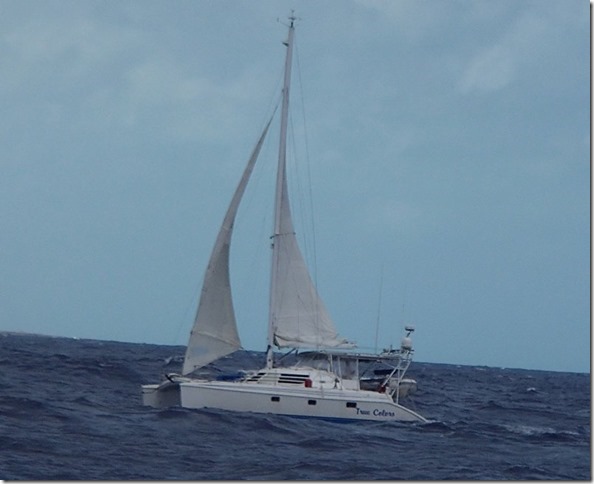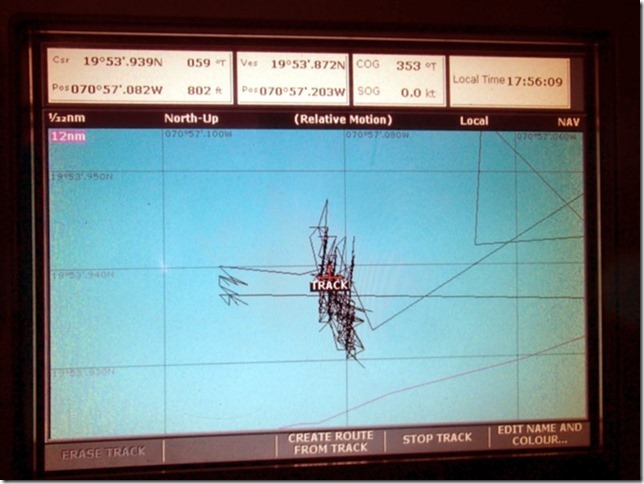Down to the Dominican Republic

Anastasia
Phil May and Andrea Twigg
Thu 15 May 2014 01:22
|
19:53.9N 70:57.0W
From Turks and Caicos the only way is down. At this time of year the
trade winds are pretty consistently from the east and the best you can do is
wait for a mild east-north-easterly wind and then sail south-south-east to the
Dominican Republic. It sounds like a simple reach, except that you have to
also allow for a knot of current pushing you westward plus the fact that the
waves tend to stick due east. Given this, the town of Luperon is about as
far east as you can make comfortable landfall in the Dominican Republic without
going close hauled and crashing through the waves.
In order to get as far upwind as possible we first made our way over the
Caicos Bank to Ambergris Cay at the south-eastern side of the bank. There
is another catamaran (True Colors) heading for Grenada so we have paired up with
them for a while. The wind was about 18 knots from the east-north-east
which meant we could sail most of the way across, doing a single big tack to the
north in the middle of the bank. We got to Ambergris at about 15:30, which
was good because you definitely need to be able to see the coral heads when
sailing in this area.
The next morning the wind had changed. Our original plan was to do
another eastward hop to Great Sand Cay and then cross to Luperon the day
after. However, the weather window was closing down Marty and I agreed
that we had to head directly from Ambergris to Luperon that morning. It
meant we would arrive at night, but we could drop anchor in a bay near Luperon
and enter the harbour the next morning.
And so we set off. The cruising guide tells you to head directly
north from the anchorage at Ambergris or you will find yourself in a maze of
coral. So we headed directly north and soon we were squeezing through a
maze of coral heads, in 20 knot winds and 3 foot waves, through gaps that were
just a few feet wider than Anastasia. Every so often a cloud would come
over and we could see nothing (apart from the coral heads that were actually
breaking through the waves) and we would have to try and hold our position and
wait for the light to come back. In the end, and still two miles south of
the waypoint given in the cruising guide, we just headed out to sea rather than
keep picking our way through treacherous coral to get to the designated
waypoint. Not a fun experience.
Out at sea we could calm down again. The wind was about as good as we
could have hoped for (ENE 20 knots) but the sea was quite confused in the
Mouchoir Channel and we kept on being hit by squalls and so had to be
conservatively double reefed. Most squalls were just rain, but one in
particular boosted the wind to 36 knots, so it was worthwhile being
reefed. We dropped anchor at 00:30 in a bay next to Cabo Isabela and then,
at 06:30 we sailed on to Luperon.
True Colors arrived at Luperon half an hour before we did, and we heard
someone on the radio telling them they were about to go aground in the mooring
field. We determined to go in very carefully, picking our way close to the
moored boats through the centre of the field. Of course the centre of the
mooring field is exactly where the sand bar is, and we got the same urgent radio
call to stop and go around the outside. You would think they might put
some markers on the sandbar, rather than having to radio every boat that comes
in.
Papo, the owner of the moorings, came out with a boatload of officials and
showed us to a mooring ball. The mooring balls are only $3 a night
here. The officials inspected the boat, took the customary tip and gave us
permission to go ashore and complete the immigration process. Papo sold us
a courtesy flag for a very reasonable $10.
If there are trade winds outside Luperon harbour then it blows up to 30
knots inside, and Andrea is always nervous for the first day in a new
place. “Does that boat look closer than it did before?” she asks every
hour. We keep a GPS plotter on to track our position so I just point her
at the black blob made of of a criss-cross of lines as we drift on the mooring
ball. But this time there were two blobs on the plotter, fully fifty feet
apart. Anastasia had actually dragged her concrete block fifty feet across
the mud and was well on the way to nuzzling up to the boat moored behind
us.
We couldn’t just assume that the dragging had stopped, not could we trust
any of the other mooring balls now, so our only option was to go and anchor
somewhere. After half an hour of cruising round looking for a space, one
of the long-term residents came over and led us to a good place, which is where
we are anchored now.
 Crossing the Caicos bank is the last time we will see these Bahamian
colours for a while
 True Colors on passage to the Dominican Republic
 Something you never want to see when moored/anchored – the track squiggles
moving 50 feet downwind!
|